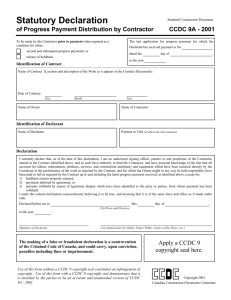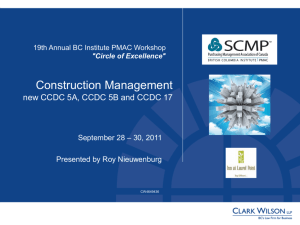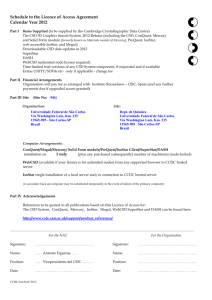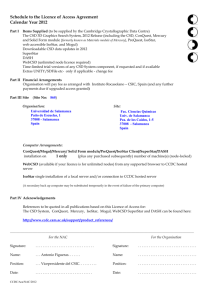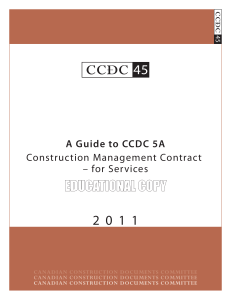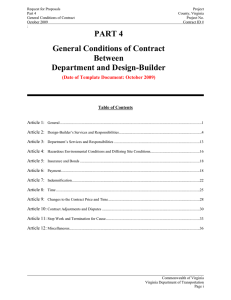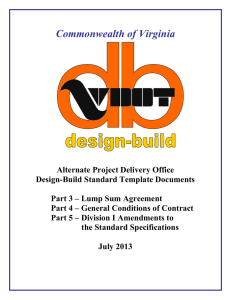An Initial Review Of The New CCDC 14
advertisement
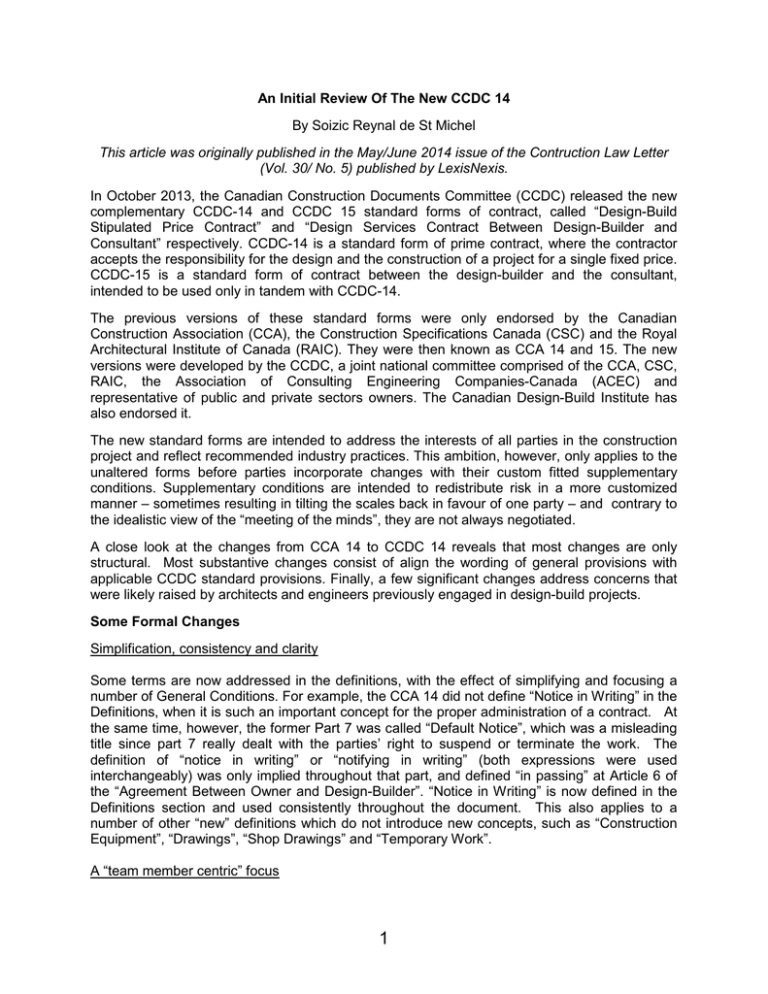
An Initial Review Of The New CCDC 14 By Soizic Reynal de St Michel This article was originally published in the May/June 2014 issue of the Contruction Law Letter (Vol. 30/ No. 5) published by LexisNexis. In October 2013, the Canadian Construction Documents Committee (CCDC) released the new complementary CCDC-14 and CCDC 15 standard forms of contract, called “Design-Build Stipulated Price Contract” and “Design Services Contract Between Design-Builder and Consultant” respectively. CCDC-14 is a standard form of prime contract, where the contractor accepts the responsibility for the design and the construction of a project for a single fixed price. CCDC-15 is a standard form of contract between the design-builder and the consultant, intended to be used only in tandem with CCDC-14. The previous versions of these standard forms were only endorsed by the Canadian Construction Association (CCA), the Construction Specifications Canada (CSC) and the Royal Architectural Institute of Canada (RAIC). They were then known as CCA 14 and 15. The new versions were developed by the CCDC, a joint national committee comprised of the CCA, CSC, RAIC, the Association of Consulting Engineering Companies-Canada (ACEC) and representative of public and private sectors owners. The Canadian Design-Build Institute has also endorsed it. The new standard forms are intended to address the interests of all parties in the construction project and reflect recommended industry practices. This ambition, however, only applies to the unaltered forms before parties incorporate changes with their custom fitted supplementary conditions. Supplementary conditions are intended to redistribute risk in a more customized manner – sometimes resulting in tilting the scales back in favour of one party – and contrary to the idealistic view of the “meeting of the minds”, they are not always negotiated. A close look at the changes from CCA 14 to CCDC 14 reveals that most changes are only structural. Most substantive changes consist of align the wording of general provisions with applicable CCDC standard provisions. Finally, a few significant changes address concerns that were likely raised by architects and engineers previously engaged in design-build projects. Some Formal Changes Simplification, consistency and clarity Some terms are now addressed in the definitions, with the effect of simplifying and focusing a number of General Conditions. For example, the CCA 14 did not define “Notice in Writing” in the Definitions, when it is such an important concept for the proper administration of a contract. At the same time, however, the former Part 7 was called “Default Notice”, which was a misleading title since part 7 really dealt with the parties’ right to suspend or terminate the work. The definition of “notice in writing” or “notifying in writing” (both expressions were used interchangeably) was only implied throughout that part, and defined “in passing” at Article 6 of the “Agreement Between Owner and Design-Builder”. “Notice in Writing” is now defined in the Definitions section and used consistently throughout the document. This also applies to a number of other “new” definitions which do not introduce new concepts, such as “Construction Equipment”, “Drawings”, “Shop Drawings” and “Temporary Work”. A “team member centric” focus 1 This focus is evident in a complete overhaul of the structure of parts 2 and 3 of the General Conditions. In CCA 14, Part 2 addressed “Design Services And Administration Of The Contract” while Part 3 addressed “Execution Of The Work”. In the new form, Part 2, “Owner’s Responsibilities” describes the responsibilities of the owner’s team: owner, owner’s advisor and payment certifier. Part 3,“Design-Builder’s Responsibilities” is broken down into the designbuilder’s specific tasks and the design-builder’s obligations with respect to consultants, subcontractors and suppliers. This provides more clarity and allows for a one-stop reference for each party to identify their specific obligations instead of searching for them throughout the General Conditions (with some exceptions like GC 2.6.3 to 2.6.6). The description of the role of the consultant is very limited because that role is now dealt with in CCDC 15. CCDC 14 is meant to be a two-party contract only, which is exactly why owners select that form of contract in the first place. The changes to Parts 2 and 3 of the General Conditions are mainly structural, as a large number of these provisions mirror pre-existing ones in CCA 14. Some Substantive changes For the balance of the general conditions, aside from parts 2 and 3, the provisions mirror the provisions and structure of other CCDC standard forms such as CCDC 2-2008, in an effort to streamline CCDC standard forms throughout the Canadian construction sector. Agreement between Owner and Design-Builder • • • • • The Design Builder shall perform Design Services and the Work, the two are no longer amalgamated, which, for example, enables the suspension or termination of the Design Services before the Work commences (GC 7.1). Two additional construction team members are identified: the Payment Certifier and the Owner’s Advisor (optional, Article 6). This gives the parties the option to divide the tasks between the consultant retained by the design-builder and the payment certifier retained by the owner. This change addresses the concern of consultants who were concerned about “serving two masters” and resulting conflicts of interests1. The calculation of interest is now scaled : 2% + prime for the first 60 days and 4%+ prime beyond 60 days, to mirror other CCDC standard forms. The Notice in Writing can only be received on Working Days (or is deemed to be received on the next following Working Day) and this applies to fax and electronic delivery. The Consultant is no longer a party to whom Notices are to be sent under CCDC 14 (instead these are dealt with in CCDC 15). Definitions • • The definition of “construction” has been eliminated as it would have created confusion now that the “design services” is a separate item which forms part of the Work. The definition of the “Construction Documents” does away with the concept of “general functional intent of the Contract Documents” and expressly includes a reference to the Owner’s Statement of Requirements. 1 Greg Meckbach, “Canadian Construction Documents Committee near release of design-build documents”, Daily Commercial News, March 2011. 2 • • • Contract Time is now calculated from “the date of the Agreement” instead of the more esoteric date of “commencement of the Work”. “Design services” are defined as the “professional design and related services” rather than “professional services for the design and administration”. “Other consultant’ is defined as a person or entity engaged by the Design-Builder to perform part of the Design Services. Copyright protection for the consultant(s) CCDC 14 offers broader copyright protection for the design consultant(s) as the owner can only use the consultant’s instruments and design for the specific project, not for any other future similar project, even with alterations, which are strictly forbidden (GC 1.1.7) “without a witten license from the Consultant or Other Consultants who prepared the documents”. In an article which reviewed three common contracts –stipulated price, construction management and design-build, David Bristow wrote: Standard forms (…) are meant to protect the interest and preserve the rights of all parties. Standardization and homogeneity in the bidding acts as a curb to costly disputes and claims by reducing any risk of misunderstanding and ambiguity. Another attractive feature of [standard forms] is that parties tend to be comfortable and familiar with the language of standard forms that are widely accepted. This results in some cost saving and time benefits to both parties as intensive 2 drafting and re-drafting of documents may not be necessary” These are certainly the intended and “ideal” attractive features of standard form contracts, this is why the CCDC members spend so much time and effort developing new forms or refurbishing existing forms. The reality is that parties spend time and money developing supplementary conditions which are sometimes tailored for each project. These supplementary conditions completely remodel the base standard form and re-allocate risk, broaden or reduce obligations (depending on who is drafting them) and quite often, they are not (really or at all) negotiated but imposed by the party who has the most leverage. 2 David I. Bristow, Q.C., Jesmond A. Parke, “An Overview of Three Commonly Used Construction Contracts – Stipulated Price Contract, Construction Management, and Design-Build”, 2000, 49 C.L.R. (2d) 265. 3
